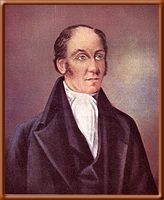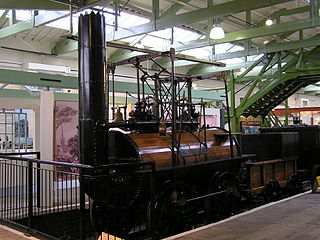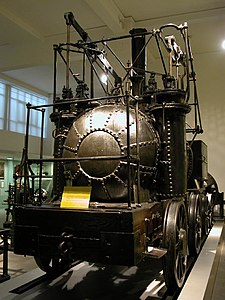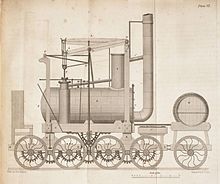
George Stephenson was an English civil engineer and mechanical engineer during the Industrial Revolution. Renowned as the "Father of Railways", Stephenson was considered by the Victorians as a great example of diligent application and thirst for improvement. His chosen rail gauge, sometimes called "Stephenson gauge", was the basis for the 4-foot-8+1⁄2-inch (1.435 m) standard gauge used by most of the world's railways.

A locomotive is a rail transport vehicle that provides the motive power for a train. If a locomotive is capable of carrying a payload, it is usually rather referred to as a multiple unit, motor coach, railcar or power car; the use of these self-propelled vehicles is increasingly common for passenger trains, but rare for freight trains.

Wagonways, also known as horse-drawn railways and horse-drawn railroad consisted of the horses, equipment and tracks used for hauling wagons, which preceded steam-powered railways. The terms plateway, tramway, dramway, were used. The advantage of wagonways was that far bigger loads could be transported with the same power.

John Blenkinsop was an English mining engineer and an inventor of steam locomotives, who designed the first practical railway locomotive.

William Hedley was born in Newburn, near Newcastle upon Tyne. He was one of the leading industrial engineers of the early 19th century, and was instrumental in several major innovations in early railway development. While working as a 'viewer' or manager at Wylam Colliery near Newcastle upon Tyne, he built the first practical steam locomotive which relied simply on the adhesion of iron wheels on iron rails.

Timothy Hackworth was an English steam locomotive engineer who lived in Shildon, County Durham, England and was the first locomotive superintendent of the Stockton and Darlington Railway.

Richard Trevithick was a British inventor and mining engineer. The son of a mining captain, and born in the mining heartland of Cornwall, Trevithick was immersed in mining and engineering from an early age. He was an early pioneer of steam-powered road and rail transport, and his most significant contributions were the development of the first high-pressure steam engine and the first working railway steam locomotive. The world's first locomotive-hauled railway journey took place on 21 February 1804, when Trevithick's unnamed steam locomotive hauled a train along the tramway of the Penydarren Ironworks, in Merthyr Tydfil, Wales.
Steam power developed slowly over a period of several hundred years, progressing through expensive and fairly limited devices in the early 17th century, to useful pumps for mining in 1700, and then to Watt's improved steam engine designs in the late 18th century. It is these later designs, introduced just when the need for practical power was growing due to the Industrial Revolution, that truly made steam power commonplace.

The North Tyneside Steam Railway and Stephenson Steam Railway are visitor attractions in North Shields, North East England. The museum and railway workshops share a building on Middle Engine Lane adjacent to the Silverlink Retail Park. The railway is a standard gauge line, running south for 2 miles (3.2 km) from the museum to Percy Main. The railway is operated by the North Tyneside Steam Railway Association (NTSRA). The museum is managed by Tyne and Wear Archives and Museums on behalf of North Tyneside Council.

Locomotion No. 1 is an early steam locomotive that was built in 1825 by the pioneering railway engineers George and Robert Stephenson at their manufacturing firm, Robert Stephenson and Company. It became the first steam locomotive to haul a passenger-carrying train on a public railway, the Stockton and Darlington Railway (S&DR).

Wylam is a village and civil parish in the county of Northumberland, England. It is located about 10 miles (16 km) west of Newcastle upon Tyne.

The Steam Horse was an early railway steam locomotive constructed by the Butterley Company in Derbyshire in 1813 by William Brunton (1777–1851). Also known as the Mechanical Traveller, it had a pair of mechanical legs, with feet that gripped the ground behind the engine to push it forwards along the rails at about three miles an hour.

Salamanca was the first commercially successful steam locomotive, built in 1812 by Matthew Murray of Holbeck, for the edge-railed Middleton Railway between Middleton and Leeds, England and it predated Stephenson's Rocket by 17 years. It was the first to have two cylinders. It was named after the Duke of Wellington's victory at the battle of Salamanca which was fought that same year.
The history of rail transport in Great Britain to 1830 covers the period up to the opening of the Liverpool and Manchester Railway, the world's first intercity passenger railway operated solely by steam locomotives. The earliest form of railways, horse-drawn wagonways, originated in Germany in the 16th century. Soon wagonways were also built in Britain. However, the first use of steam locomotives was in Wales. The invention of wrought iron rails, together with Richard Trevithick's pioneering steam locomotive meant that Britain had the first modern railways in the world.
The Blacketts of Wylam were a branch of the Blackett family of Hoppyland, County Durham, England and were related to the Blackett baronets.

Wylam Dilly is the second oldest surviving railway locomotive in the world; it was built circa 1815 by William Hedley and Timothy Hackworth for Christopher Blackett, the owner of Wylam colliery, west of Newcastle upon Tyne. Wylam Dilly was initially designed for and used on the Wylam Waggonway to transport coal. The four driving wheels are connected by a train of spur wheels driven by a central crankshaft.

A shell or flued boiler is an early and relatively simple form of boiler used to make steam, usually for the purpose of driving a steam engine. The design marked a transitional stage in boiler development, between the early haystack boilers and the later multi-tube fire-tube boilers. A flued boiler is characterized by a large cylindrical boiler shell forming a tank of water, traversed by one or more large flues containing the furnace. These boilers appeared around the start of the 19th century and some forms remain in service today. Although mostly used for static steam plants, some were used in early steam vehicles, railway locomotives and ships.

George Stephenson built a number of experimental steam locomotives to work in the Killingworth Colliery between 1814 and 1826.

Christopher Blackett owned the Northumberland colliery at Wylam that built Puffing Billy, the first commercial adhesion steam locomotive. He was also the founding owner of The Globe newspaper in 1803.

Steam springs or steam suspension are a form of suspension used for some early steam locomotives designed and built by George Stephenson. They were only briefly used and may have been used for fewer than ten locomotives.



















